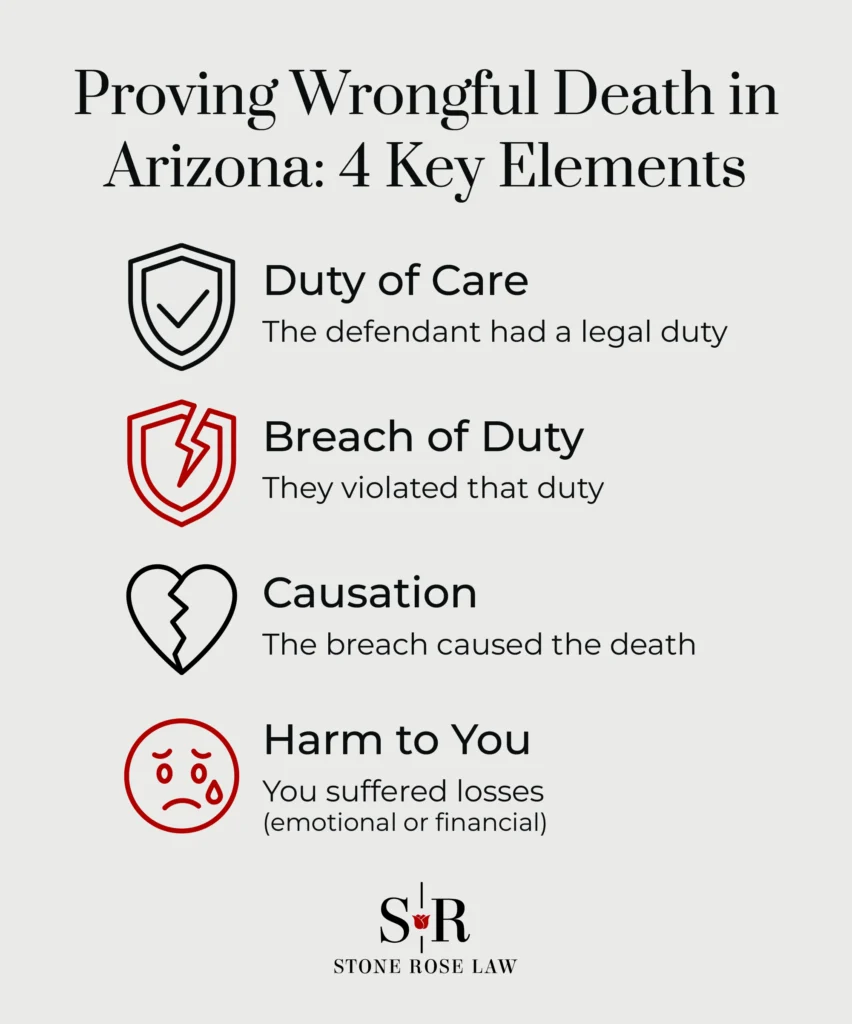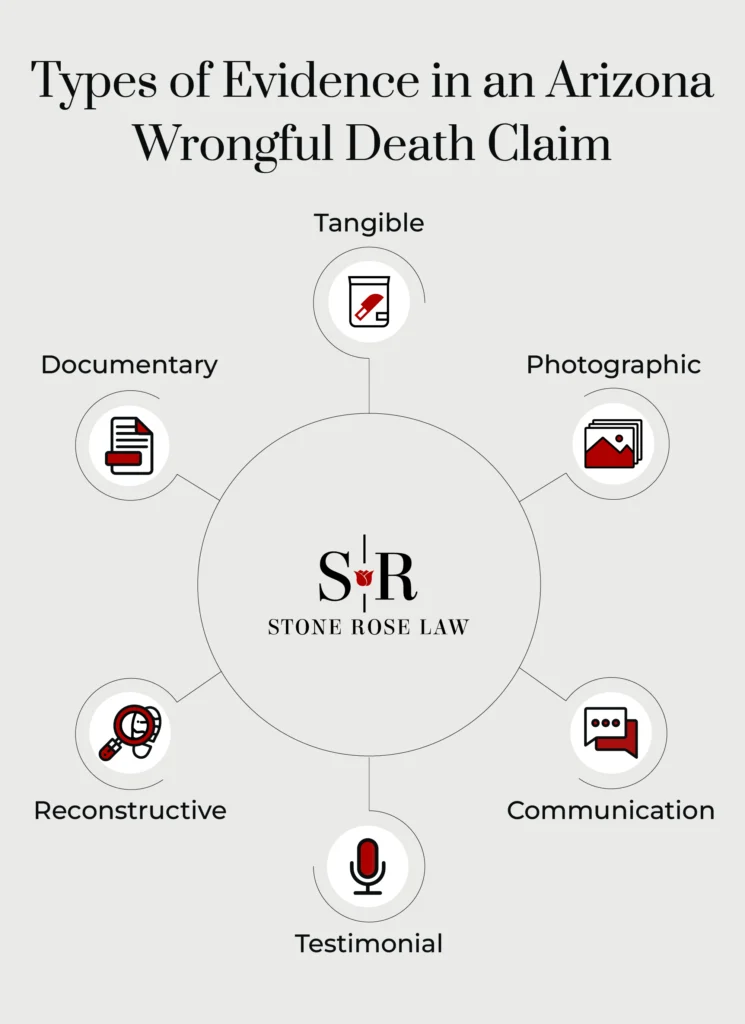All civil lawsuits in Arizona, including wrongful death claims, have specific elements you must prove to win your case. In this post, we discuss what goes into carrying a plaintiff’s burden of persuasion in a wrongful death suit.
If you would like to speak with an attorney about a wrongful death case, please call Stone Rose Law at (480) 631-3025 or use our contact form.
There are four elements to a wrongful death claim. You must prove that all of the below happened:
Next, let’s consider proof considerations for each of these elements.

A duty of reasonable care to others depends on the circumstances.
For example, when a person drives a car, the duty of reasonable care includes obeying traffic laws and traffic signals, driving in a way that is safe given the existing weather, lighting, and road conditions, and not driving under the influence of alcohol or drugs.
In a slip-and-fall wrongful death suit, a property owner or manager’s reasonable duty of care can include addressing dangerous conditions on the property in a timely manner and alerting non-trespassers of their existence.
When proving the duty of reasonable care existed, your attorney will need to identify the circumstances surrounding the act, or failure to act, that caused the harm that led to your loved one’s death. Then, your attorney will need to establish what the defendant’s reasonable duty of care was under those circumstances. This is a fact-specific consideration that will vary from case to case.
Once you have shown that the defendant owed your deceased loved one a duty of reasonable care, you will need to prove that the defendant did not observe that duty. The violation of the duty of reasonable care can be the result of negligence, recklessness, or even an intentional act. This is another fact-specific process that will depend on the evidence your attorney presents to the jury:
Lawyers refer to causation in a personal injury lawsuit or a wrongful death suit as “proximate causation.” What this means is that to prove causation, the defendant’s breach of the duty of care must have been either the direct cause of death or the proximate cause of the death. In other words, the defendant’s act cannot be so tangentially or indirectly connected to the death.
This connection between the breach of duty and the ensuing death that resulted makes this element the most challenging to prove in a wrongful death lawsuit. Defendants will often claim that some other act or circumstance was the true cause of death, including, just to name a few:
Your attorney will need to present evidence that is compelling enough to persuade a jury that it was, in fact, the defendant’s act that led to the loss of your loved one, and to anticipate and overcome any alternative causation explanations the defense can be expected to offer. This can include calling upon expert witnesses, accident reconstruction specialists, and medical professionals.
Even if you are able to prove the first three elements above, you will still need to show that the loss of your family member has caused you harm. Arizona law recognizes several ways that you can prove harm to you in a wrongful death action.
Harm can be broken down into three categories:
Economic damages are also known as direct damages. These are types of harm that you can prove through cost calculations and billing costs. Examples of economic damages include:
Non-economic damages, also known as indirect damages, are harder to prove than direct damages because they are more subjective. Examples of non-economic harm you can suffer include:
Proving noneconomic damages may rely on evidence including witness testimony about the effects the decedent’s death has had on you, testimony of mental health professionals, and your own testimony.
Despite their more challenging proof requirements, non-economic damages are important to establish because often, once you can convince the jury that you have suffered them, they often result in higher damages awards than direct damages do. A wrongful death lawsuit that results in hundreds of thousands of dollars worth of direct damages costs can include non-economic damages amounts of millions of dollars.
Punitive damages, sometimes called exemplary damages, are not allowable in every wrongful death suit.
To be entitled to them, you must present evidence to show that the defendant’s conduct was intentional, malicious, or otherwise so egregious that an award of non-economic damages will not suffice to address the nature of the harm you have suffered.
What constitutes egregious conduct in the minds of a jury can mean presenting evidence allowing them to conclude what the defendant’s state of mind was at the time of the death-causing event. This can include testimonial evidence of witnesses, expert witnesses, video recordings, material evidence, and circumstantial evidence.
In a civil lawsuit like a wrongful death action, unlike in a criminal case, you will not need to prove each of the four elements beyond a reasonable doubt. Your burden of persuasion in a civil case is instead based on showing a “preponderance of the evidence” that each element is met.
This is another way of saying that your evidence must convince the jury: that it is more likely than not that the defendant’s behavior and its consequences satisfy each element. Sometimes this is expressed in mathematical terms: if the jury concludes that it was 51% likely that your evidence proves an element of your claim, then your burden of persuasion has been met.
Some of the types of evidence you can introduce in a wrongful death lawsuit include your own testimony, the testimony of expert and non-expert witnesses, and documentary evidence like medical records and medical bills.
Your wrongful death attorney will do a thorough factual investigation of your claim to identify what kinds of evidence you will need to receive compensation through settlement or litigation and what kinds of evidence are available.

Some of the kinds of evidence your attorney can gather include:
Proving that another person’s acts led to the loss of a loved one is a matter of establishing facts through evidence. Even though most wrongful death claims settle out of court, it is still necessary to collect enough persuasive evidence to convince an insurance company of the defendant or defendants to negotiate seriously with you, and to see that you recover compensation for the loss of your loved one.
At Stone Rose Law, our wrongful death attorneys are highly skilled in investigating wrongful death cases. We will identify everyone who is potentially liable and gather as much evidence as possible to prove each element of a wrongful death lawsuit against them in civil court.
We will negotiate with defense attorneys and insurance claim adjusters on your behalf to ensure you do not become a victim of a lowball settlement offer. If necessary, we will represent you in a civil action for wrongful death should negotiations not yield sufficient financial compensation.
Call us at (480) 631-3025 or contact us online to schedule a free consultation with a Phoenix wrongful death attorney.